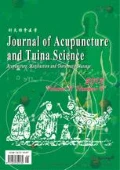Abstract
Objective
To observe the clinical efficacy of acupuncture at abdomen acupoints plus tuina for lumbar intervertebral disc herniation (LIDH).
Methods
A total of 70 patients with LIDH were randomized into an observation group and a control group, with 35 cases in each group. The observation group was treated with acupuncture at abdomen acupoints plus tuina, while the control group was treated only with tuina treatment. The clinical efficacy was observed after one course of treatment.
Results
The cure rate and the total effective rate of the observation group were 83.3% and 96.7%, respectively. The cure rate and the total effective rate of the control group were 39.4% and 78.8%, respectively. There were significant differences in the cured rate and the total effective rate between the two groups (both P<0.05). There was no significant difference in Japanese Orthopedic Association (JOA) score between the two groups before treatment (P>0.05). After treatment, the JOA scores of both groups increased significantly, and the intra-group differences were statistically significant (both P<0.05); the JOA score of the observation group was significantly higher than that of the control group (P<0.05).
Conclusion
Acupuncture at abdomen acupoints plus tuina has a better therapeutic effect than tuina alone in the treatment of LIDH.
概要
目的
观察针刺腹部穴位加推拿治疗腰椎间盘突出症的临床疗效。
方法
将70例腰椎间盘突出症患者随 机分为观察组和对照组, 每组35例。观察组采用针刺腹部穴位加推拿治疗, 对照组仅采用推拿治疗。治疗1个疗 程后观察疗效。
结果
观察组痊愈率和总有效率分别为83.3%和96.7%, 对照组痊愈率和总有效率分别为39.4%和 78.8%, 两组痊愈率及总有效率差异均有统计学意义(均P<0.05)。治疗前, 两组JOA评分差异无统计学意义 (P>0.05)。治疗后, 两组JOA评分均明显升高(均P<0.05 ), 与本组治疗前差异均有统计学意义(均P<0.05); 治疗组 JOA评分高于对照组, 组间差异有统计学意义(P<0.05)。
结论
针刺腹部穴位加推拿治疗腰椎间盘突出症的临床 疗效优于单独推拿治疗。
Similar content being viewed by others
References
Huang ZQ, Zhang S, Wang WM, Song YW, Yang Z, Cheng LP, Shen LR, Wang S, Fu SS. Observations on the efficacy of silver needle acupuncture plus instrumental ginger moxibustion in treating lumbar intervertebral disc herniation. Shanghai Zhenjiu Zazhi, 2017, 36(2): 193–197.
Hu YG. Lumbar Disc Herniation. 3rd Edition. Beijing: People’s Medical Publishing House, 2004: 3.
Kreiner DS, Hwang SW, Easa JE, Resnick DK, Baisden JL, Bess S, Cho CH, DePalma MJ, Dougherty P 2nd, Fernand R, Ghiselli G, Hanna AS, Lamer T, Lisi AJ, Mazanec DJ, Meagher RJ, Nucci RC, Patel RD, Sembrano JN, Sharma AK, Summers JT, Taleghani CK, Tontz WL Jr, Toton JF; North American Spine Society. An evidence–based clinical guide line for the diagnosis and treatment of lumbar disc herniation with radiculopathy. Spine J, 2014, 14(1): 180–191.
Japanese Orthopaedic Association. Assessment of surgical treatment of low back pain. J Jpn Orthop Assoc, 1984, 58(12): 1183–1187.
State Administration of Traditional Chinese Medicine. Criteria of Diagnosis and Therapeutic Effects of Diseases and Syndromes in Traditional Chinese Medicine. Beijing: China Medical Science Press, 2012: 214–215.
Lei LM. Clinical progress of tuina treatment for lumbar intervertebral disc herniation in recent 10 years. J Acupunct Tuina Sci, 2012, 10(2): 128–132.
Yu LZ, Li MD, Lou SZ, Mao J, Sun ZQ, He TY, Yan XK. Observaton on therapeutic effect of aligned acupuncture for lumbar intervertebral disc herniation. J Acupunct Tuina Sci, 2016, 14(3): 211–215.
Sheng YG, Xian JH, Xu HB. Observations on the efficacy of heat–sensitive point medicinal moxibustion plus percutaneous administration of tetrandrine in treating lumbar intervertebral disc herniation. Shanghai Zhenjiu Zazhi, 2018, 37(3): 320–323.
Song XG, Jia H, Liu TM. Clinical observation on 152 cases of lumbar disc herniation treated by Chinese medicine combined with tuina. Ningxia Yixue Zazhi, 2017, 39(11): 1035–1036.
Wu CY, Lin T, Zheng ZG, Zhang HM. Treatment of 90 cases of lumbar disc herniation by abdominal tuina combined with electric traction. Zhongguo Zhongyi Gushangke Zazhi, 2015, 23(10): 62–64.
He X, Zhou RJ. Clinical observation on lumbar disc herniation (syndrome of impediment obstruction of cold–dampness) treated by abdominal tuina combined with Chinese medicine. Zhongguo Zhongyi Jizheng, 2018, 27(1): 137–139.
Yang BW. Observations on the efficacy of tuina manipulation and related non–surgical therapy in treating lumbar intervertebral disc herniation. Neimenggu Zhongyiyao, 2016, 37(14): 138–139.
He XT, Wang K, Gao YN. Clinical research on treating lumbar disc herniation with acupuncture at initial point combined with tuina. Shiyong Zhongyiyao Zazhi, 2016, 32(12): 1149–1151.
Tan HR, Xu MJ, Zeng J, Wang XQ, Cheng CJ, Liu YY, Gao XQ, Li LM, Wang HF, Dai JS. Clinical observation on treating lumbar disc herniation with abdominal acupuncture, box moxibustion and massage for 52 cases. Xibu Zhongyiyao, 2011, 24(9): 13–15.
Su J, Shen SE. Clinical observation on intergrated abdomen and wrist–ankle acupuncture for lumbar intervertebral disc herniation. Shanghai Zhenjiu Zazhi, 2011, 30(10): 691–692.
Li SQ. Clinical observation on treating lumbar disc herniation with abdominal acupuncture and ginger partitioned moxibustion. Shenzhen Zhongxiyi Jiehe Zazhi, 2015, 25(1): 66–68.
Xue G, Ma BN, Xu Y, Li JA, Wang SY, Yang J, Guan YB. Effect of Weiling Duhuo decoction in treating blood stasis kind of lumbar disc herniation through Bladder Meridian fumigation treatment. Zhongguo Yiyao, 2015, 10(7): 1009–1011.
Chen YJ, Ma ZJ, Si LX, Liu YR, Zhang YJ, Ji PC, Liang J, Zhang ZD. Research on clinical efficacy of bloodactivating and collateral vessels freeing method combined with warm needling in treating lumbar disc herniation of blood stasis syndrome. Hebei Zhongyiyao Xuebao, 2015, 30(4): 48–51.
Chen LQ, Liu LF, Wang YR, Zhang W. Clinical observation on 33 cases of lumbar disc herniation treated by abdominal acupuncture combined with motive moxibustion. Hebei Zhongyi, 2015, 37(2): 244–246.
Di HY, Han SK, Du XL, Li WW, Jian J. Applying tuina to exterior–interiorly connected meridians for post–stroke upper limb spasticity. J Acupunct Tuina Sci, 2017, 15(1): 27–30.
Qiu Y. A control study of acupuncture and massage in the treatment of lumbar disc herniation. Zhong Wai Yiliao, 2015, 34(19): 181–182.
Acknowledgements
This work was supported by 2017 Science and Technology Development Project of Tonglu County, Hangzhou (2017 年杭州市桐庐县科技发展计划项目, No. 2017C013).
Author information
Authors and Affiliations
Corresponding author
Rights and permissions
About this article
Cite this article
Yu, Nt., Liu, Yd., Xiong, Sb. et al. Observation on therapeutic effect of acupuncture at abdomen acupoints plus tuina for lumbar intervertebral disc herniation. J. Acupunct. Tuina. Sci. 17, 56–61 (2019). https://doi.org/10.1007/s11726-019-1093-z
Received:
Accepted:
Published:
Issue Date:
DOI: https://doi.org/10.1007/s11726-019-1093-z
Keywords
- Acupuncture Therapy
- Points, Chest &
- Abdomen
- Tuina
- Massage
- Low Back Pain
- Intervertebral Disc Displacement
- Pain Measurement


